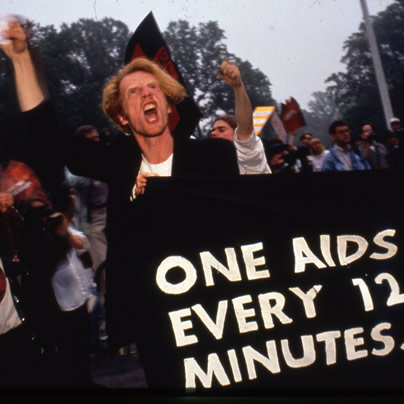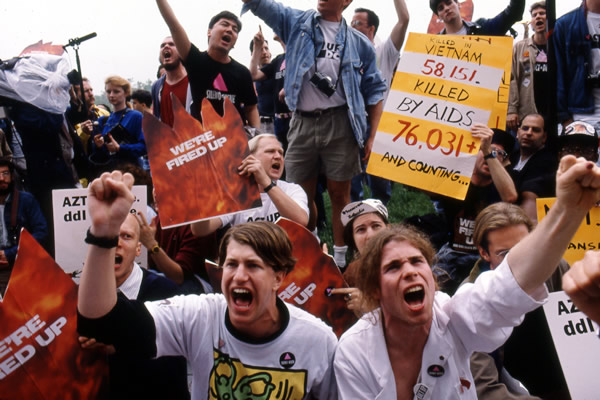Living
Surviving Oscar
Gay writer scores Academy nomination for debut film about AIDS


A scene from David France’s harrowing documentary ‘How to Survive a Plague.’ The film has its Oscar rendezvous Sunday night at the Dolby Theatre in Hollywood where its up for Best Documentary. (Photo courtesy Sundance Selects)
It sounds so straightforward — the New York Public Library had a collection of videotapes AIDS activists made decades ago with vintage camcorders back when they were heavy behemoths you had to rest on your shoulder with full-size VHS or Beta tapes inside. Filmmaker/journalist David France combed painstakingly through the clips to compose his powerful 2012 documentary “How to Survive a Plague.”
But how this was achieved — what format was the footage stored in? What condition was it in? Could anyone go in and check these out with a library card? How did France pull this off?
In some ways, it’s the least interesting part of the film’s story, which is told via a sobering chronology of video footage shot by angry protesters — the kind the Religious Right calls “militant homosexual activists.”
The film has been almost universally praised. The New York Times called it “inspiring” and crackling with “currents of rage, fear, fiery determination and finally triumph.” It has a 100 percent freshness rating among critics on Rotten Tomatoes (a film quality-ranking site), several awards including “best documentary” from the Boston Society of Film Critics. This weekend it’s up for both an Independent Spirit Award and an Oscar. Gold Derby, a site that predicts entertainment industry awards, gives it a 4/1 chance at winning the Oscar (behind “Searching for Sugar Man” which it gives 13/8 odds). “5 Broken Cameras,” “The Gatekeepers” and “The Invisible War” (made by the “Outrage” team of Kirby Dick and Amy Ziering) are also nominated.
For “Plauge,” France took footage — some of which was housed at the New York Public Library — shot by 31 videographers and paces it chronologically to the story of the formation of ACT UP (AIDS Coalition to Unleash Power), a group that formed in March 1987 in a spirit of extreme frustration during a speech activist (and “Normal Heart” playwright) Larry Kramer gave at the Lesbian and Gay Community Services Center in New York.
France, during a lengthy phone interview last weekend before he was scheduled to fly to Los Angeles on Tuesday, gladly shares the logistics behind “Plague’s” formation.
A veteran investigative journalist, author and GLAAD Media Award winner (for a GQ piece on gays in Iraq) who’s had his work published in everything from the New Yorker to Ladies’ Home Journal, France says he was a graduate student during the time AIDS hit in the early 1980s and having written about it extensively over the years, he knew activists had brought cameras to their protests. And yes, the process of crafting “Plague” was a lot more involved than simply checking tapes out of the library.
“The tapes from the library are actually just a small portion of the footage you see in the film,” France, who’s gay, says. “That’s really the first door I went through, this archive of AIDS activism video that’s housed in the Manuscript Division of the New York Library, where you go if you want to read Lincoln’s letters. It’s an exclusive corner of the library that’s not accessible to the general public and everybody’s going around wearing white gloves and handling antiquities. In one corner, they have a television and a VCR and you watch the AIDS footage recorded in those early days. It’s just raw footage, not really ever intended for public view. Some of it you’ll be watching and all of a sudden it will go to a gay porn video, which just happened to be on the same tape they recorded on.”
France says the library kept all the tapes — recorded in every home video format on the market in those years as one might imagine — but had transferred them all to the Betacam SP format, a higher resolution tape on larger cassettes that for years was the broadcast standard and is still in use today. France convinced the library to let him take select footage to a nearby production lab and have it digitized. He ended up with about 100 hours and says the process became difficult as the project moved along.
“They’re really not accustomed to working on a film production schedule, so trying to get them to hurry got more and more difficult as we went along,” he says.
And that was just the starting point — in the library footage, France saw other people holding video cameras. He started tracking them down one by one and eventually found a group of people, many long-time AIDS survivors themselves, who had videotape footage they had never revisited. Again, formats remained a challenge.
“We had all this stuff in so many different formats from private collections,” he says. “We were constantly scouring Craigslist and eBay for decks that would play these old tapes. We ended up with about 800 hours and that really became the building blocks of the film.”
And yes, France says it did take some persuasion to get these individuals to hand over their footage.
France says, “A lot of these people had moved on but I think now have started to see the real value in this footage. I think they gradually started to realize, that yes, enough time has passed and now is the time to really use it and this is the project.”
France said his project is timely and important because many of the other landmark AIDS pieces, from Kramer’s play to Randy Shilts’ “And the Band Played On” were written before the era of anti-retroviral therapy when HIV morphed into a more manageable condition.
He says the film is important for anyone interested in the AIDS fight to see.
“There were even people in ACT UP who didn’t know the outcomes of many of these things,” he says. “If you think you know the story of AIDS, this film will surprise you and that goes for just about everybody.”
http://www.youtube.com/watch?v=wwhFS1mUaVY
WASHINGTON BLADE: Will this be your first time at the Academy Awards?
DAVID FRANCE: Yes. I’ve never gotten any closer before than my television screen.
BLADE: Have you watched very often over the years?
FRANCE: Oh yeah. My boyfriend and I always have an Oscar party. With ballots and everything. I’ve never won.
BLADE: What’s your favorite Oscar memory?
FRANCE: Tom Hanks’ acceptance speech when he won for “Philadelphia.” That’s really seared in my memory.
BLADE: What did you think of Michael Moore’s controversial speech when he won the category you’re up for? Ballsy or inappropriate for the occasion?
FRANCE: I think if you’ve got an audience of a billion people and you’ve got something to say, you need to say it. That’s not to say I’m intending any surprises should I have that opportunity.
BLADE: Have you seen the competition?
FRANCE: Of course. They’re all brilliant films.
BLADE: If you win, where will you put Oscar?
FRANCE? I’m not sure. I keep the other awards we’ve won in the production office so everyone on the crew can enjoy them and hopefully see their own contribution but if we get this little gold thing, I’m not sure. I have no idea.
BLADE: Do you feel AIDS, as horrible as it was and is, put gay issues on the national radar and that ended up being a silver lining to the cloud or is that an absurd oversimplification?
FRANCE? No, it’s absolutely true. Before that, gay people were entirely disenfranchised and we were not seen as being contributing members to the culture at all. We had no role whatsoever in civic life … From those ashes (of AIDS), now we have a president who acknowledges us as human beings and Stonewall is mentioned in the same breath as Seneca Falls.
BLADE: How did you feel when Dustin Lance Black won for “Milk”?
FRANCE: I felt it was incredible. He gave a great speech and I thought it was a very, very good movie.
BLADE: Did you plan all along to submit it for a nomination? What’s the process like?
FRANCE: There are all kinds of rules about it playing in New York and L.A. and being reviewed by the New York Times and the Los Angeles Times and that’s just the first threshold. I was lucky I had a distributor who saw the potential for the film early on and made sure we did everything we needed to do for both the Oscars and the Independent Spirit Awards. … Anytime you make a film, sure, you fantasize about getting an Oscar nomination and it’s really just because you want more people to see it. An Oscar bump is a tremendous thing.
Advice
How to cope when a partner gives you the silent treatment
Punishing behavior brings up memories of parent’s mistreatment

Michael,
My wife and I met less than two years ago and we were crazy about each other from the start. We wanted to spend life together so we just went for it. Maybe this wasn’t the most well-thought out decision on either of our parts but we thought that love conquers all.
But lately we’ve been arguing. The stuff we’re fighting about is never such a big deal: chores, or spending, or wanting to do different things on the weekend. But when I don’t want to go along with Michelle’s point of view, she gets angry and shuts down. Sometimes she stops talking to me for as long as a few days.
This is painful for me. My mom used to pull this stunt when I was a kid and she was mad at me. She also cut me off when I came out. We’re still estranged.
Michelle has a whole different take on this. She says I am being “mean” to her (when I don’t go along with what she wants) and this is painful, and she has to “take a break” to cool off.
I know she comes from a volatile family. She has told me there was a lot of screaming in her house, and she barely has a relationship with her parents as a result. So I get that she’s sensitive to conflict.
But I don’t think I’m being mean to her by standing up for what I want — certainly not enough to warrant her giving me the silent treatment.
We got married to have a great life together. We often do but I can’t live with someone who just shuts me out when she’s annoyed with me.
If I became a doormat and went along with everything she wants and never pushed back or complained, maybe she wouldn’t shut down. But I don’t want to do that.
I’d appreciate some ideas to improve the situation. I don’t want a divorce but I also don’t want to keep being mistreated.
Michael replies:
You can think of marriage — or any serious relationship — as a gym where you have ongoing opportunities to become an increasingly resilient person in the face of the ongoing challenges that an intimate relationship poses.
Your task here is to shift your focus toward figuring out how to handle yourself well, even in the awful circumstance of getting the silent treatment.
Michelle is not under an obligation to behave as you’d like her to. You can certainly ask her to stop withdrawing when she’s angry at you. But that doesn’t mean she is going to honor your request.
I well understand that Michelle’s punishing behavior is bringing up painful memories of your mother’s mistreatment. But if she doesn’t change her behavior, you have to find a way to live with Michelle as she is, with as much equanimity as you can muster, for as long as you choose to be married to her. If she does not change and you find her behavior to be unbearable, you can leave.
Every time she shuts down, Michelle is handing you an opportunity to figure out how you, yourself, can deal with feeling hurt and let down, rather than depending on someone else to behave as you’d like her to, or not upset you, or soothe you. Being in charge of your own mood rather than letting someone else press your buttons is a great skill to get better at.
I’m not going focus on what techniques you might use to soothe yourself — that’s a different column (or even better, a number of therapy sessions). That said, knowing that Michelle’s behavior comes from her history might help you to take it less personally. And, simply keeping in mind that living with a difficult spouse is unavoidable and worth getting better at may help you to quiet yourself down.
Another challenge that your marriage is pushing you to work on: Discerning when you can be generous, and when it is important to have a boundary. Of course, I understand that you don’t want to be a doormat by going along with whatever Michelle says and wants. But is it possible that she has a point, in that you could stand to lean more in her direction?
None of us get to have everything the way we want when we are in a relationship (much less in life). Figuring out the interplay between generosity and boundary is complicated. It often involves considering what is important to your partner; and deriving joy from her getting some of what is important to her, not only from your getting what you would like. And of course, it also involves figuring out what is most important to you.
If you set a boundary thoughtfully, because something is important to you, and Michelle doesn’t like it, you’re being handed an opportunity to get better at tolerating disappointment. Being a disappointment to your partner, and being disappointed in your partner, are both unavoidable parts of marriage: We’re all different, and at times will make choices that the other person really does not like.
If we make our decisions from a place of integrity rather than whim, entitlement, anger, or “whose turn it is”, and strive to honor the choices that our partners make from a place of integrity, this often makes the disappointment easier to bear.
Of course, it would be great if Michelle would join you in working to become a more solid and resilient spouse. As I mentioned earlier, you can’t persuade her to do so. But you can certainly tell Michelle what you are working on and ask her to consider how she, too, might use your relationship difficulties as a challenge to grow.
It isn’t easy to have such a conversation without sounding condescending. You are better positioned to do so when you are walking the walk, not just talking the talk. One good rule of thumb is to put you and your partner in the same boat, making it clear that you see the two of you as facing the same challenges, rather than positioning yourself in a superior position. Another is to initiate the conversation when you are both calm, rather than in the middle of a fight or when you’re getting the silent treatment.
One more point: If Michelle is willing, I’d suggest that you propose couples therapy as an opportunity for you two to collaborate on building a consistently loving relationship where neither of you lets your reactivity run the show.
Michael Radkowsky, Psy.D. is a licensed psychologist who works with couples and individuals in D.C. He can be found online at michaelradkowsky.com. All identifying information has been changed for reasons of confidentiality. Have a question? Send it to [email protected].

Electric-vehicle tax credits may have faded earlier this year, but EVs themselves are far from losing their spark. There are more charging stations than ever, battery ranges are longer and more realistic, and automakers have finally figured out that EVs don’t all need to look like geeky science projects or feel like failed beta tests.
Just look at these two compact electrics, which are futuristic, fun and flexible enough for work or play.
HYUNDAI IONIQ 5
$37,000 to $48,000
Range: 245 to 318 miles
0 to 60 mph: 4.5 to 7.4 seconds
Cargo space: 26.3 cu. ft.
PROS: Fast charging. Roomy cabin. Silky-smooth suspension.
CONS: Wide turning radius. Rear wiper not on all trims. Price creep.
After being introduced three years ago, what’s new for the latest Hyundai Ioniq 5? Mostly refinement. Charging is quicker, software is smarter and Hyundai continues to quietly listen to feedback, tweaking ride comfort and usability. Think of it as switching from messy eyeliner to a perfectly sharp wing.
Exterior styling remains one of this EV’s biggest conversation starters. Those pixel-inspired lights, crisp lines and slick hatchback-meets-crossover proportions exude refreshing confidence. There’s no trying to blend in, and that’s the point. Park this Hyundai anywhere and heads will turn.
On the road, the Ioniq 5 prioritizes calm over chaos. Steering is light, the suspension smooths out rough pavement and acceleration feels brisk without being aggressive. Safety tech is plentiful and well-calibrated—adaptive cruise control, lane-centering, blind-spot monitoring—all working together without seeming like a nervous backseat driver. IOW, this ride is supportive, not clingy.
Inside, the user-friendly cabin shines. The flat floor and long wheelbase create a lounge-like atmosphere, with excellent legroom and airy visibility. Seats are well-bolstered and available with eco-friendly materials, and the sliding center console adds flexibility. Cargo space is generous, and the wide windshield makes city driving stress-free. Alas, the rear wiper is only available on select models. Overall, though, I appreciated how everything looks modern without feeling cold.
What makes this Hyundai special is its vibe. An EV that embraces individuality without shouting about it.
Fun fact: The Ioniq’s ultra-fast charging can add hundreds of miles in under 20 minutes—perfect for those who hate waiting almost as much as they hate small talk on awkward first dates.
VOLKSWAGEN ID.4
$46,000 to $59,130
Range: 206 to 291 miles
0 to 60 mph: 4.4 to 7.7 seconds
Cargo space: 30.3 cu. ft.
PROS: Sure handling. Decent range. Good storage.
CONS: Body roll in curves. Fussy infotainment. No frunk.
The latest VW ID.4 focuses on polish. Software updates have fixed earlier frustrations, and overall drivability feels more cohesive. Less “learning curve” and more “hop in and go,” like a dependable bestie who doesn’t overthink things.
Styling-wise, this EV is intentionally inoffensive. Soft curves, friendly lighting and a familiar crossover shape make it approachable. While the ID.4 won’t turn heads like the Ioniq 5, that’s OK. It’s more akin to a classic outfit that always works—timeless, not trendy.
Driving the ID.4 is relaxed and predictable. This SUV prioritizes comfort over thrills, with a suspension tuned for daily commuting and long highway drives. Safety features are comprehensive and reassuring, including excellent lane assistance and collision-prevention systems. It’s the kind of car that quietly has your back, no drama required.
Inside, the ID.4 offers a calm, uncluttered cabin with good space for passengers and cargo alike. Rear-seat legroom is especially strong, making it a solid road-trip companion. The seats are plush, visibility is good and while the infotainment system isn’t the most intuitive, it’s improved enough to be more than tolerable.
The ID.4’s special sauce is balance. It doesn’t try to reinvent the wheel—it just electrifies it.
Fun fact: This is one of the most globally popular EVs, proving that sometimes being universally liked is a strength, not a personality flaw. Think, gold star gay who still surprises you.

Real Estate
Child- and pet-proofing your home for the holidays
It isn’t about being perfect but about being prepared

The holidays are meant to be joyful, cozy, and full of laughter — but if you have young children or pets, they can also feel a little chaotic. Twinkling lights, shiny decorations, guests coming and going, and tables full of tempting food can turn your home into a wonderland of curiosity and mischief. The good news? With a little thoughtful planning, you can keep the holiday magic alive while making your home safer for everyone who lives there.
There’s something oddly comforting about movies where animals go to war with holiday decorations, turning carefully strung lights and perfectly placed ornaments into chaos. Whether it’s a mischievous dog tangled in tinsel or a curious cat launching a full-scale assault on a Christmas tree, these scenes tap into a universal experience for pet owners.
The humor comes from the contrast: the human characters are trying to create warmth, tradition, and picture-perfect cheer, while the animals see the decorations as toys, obstacles, or personal enemies. The resulting destruction — trees tipping over, ornaments shattering, lights blinking out—feels exaggerated but relatable, especially during the already hectic holiday season.
Let’s start with decorations because they tend to be the biggest attraction. Ornaments sparkle, garlands dangle, and everything seems designed to be touched, pulled, or tasted. If you have little ones or pets, consider placing your most fragile ornaments higher on the tree and using shatterproof options on the lower branches. Tinsel and ribbon may look festive, but they can be dangerous if swallowed, so skipping them or keeping them well out of reach is a simple way to reduce risk without sacrificing style.
Holiday lights are another favorite fascination. Before hanging them, take a few minutes to inspect each strand for frayed wires or broken bulbs. Secure cords along walls or behind furniture so they’re harder to grab or chew and unplug them when you leave the house or head to bed. Not only does this help prevent accidents, but it also gives you one less thing to worry about during a busy season.
The Christmas tree itself can become a focal point for exploration. Make sure it’s sturdy and well-anchored so it doesn’t tip if a toddler tugs on a branch or a pet decides to investigate. If you use a real tree, cover the water base since tree water can contain additives that aren’t safe if consumed. For artificial trees, keep an eye out for loose pieces or needles that could become choking hazards.
Food is a big part of holiday celebrations, and it’s also one of the most common sources of trouble. Many traditional treats—like chocolate, grapes, raisins, alcohol, and foods containing xylitol—are dangerous for pets. Keep plates and serving dishes up high, secure the trash can, and gently remind guests not to slip pets or kids “just a little bite” without checking first. For children, be mindful of hard candies, nuts, and small treats that could pose choking risks.
Candles and fireplaces add warmth and charm, but they deserve extra caution. Flameless candles are a wonderful alternative if you want ambiance without worry. If you do use real candles, place them well out of reach and never leave them unattended. Fireplaces should always have a sturdy screen or gate, especially with crawling babies or curious pets nearby.
Holiday gatherings bring wonderful energy into your home, but they can also create new challenges. Doors opening frequently make it easier for pets to slip outside, so consider setting up a quiet, comfortable space where they can relax during busy get-togethers. This can help reduce stress for them and give you peace of mind. For children, stair gates, locked cabinets, and clear boundaries can help prevent accidents when there’s extra excitement in the air.
New toys and gifts are another thing to watch closely. Packaging, twist ties, plastic wrap, and especially button batteries should be cleaned up promptly. These items are easy to overlook in the excitement of gift-opening but can be dangerous if swallowed. Taking a few minutes to tidy up as you go can make a big difference.
Lastly, try to keep routines as steady as possible. The holidays naturally disrupt schedules, but familiar mealtimes, naps, walks, and bedtime rituals help children and pets feel secure. A calmer household often means fewer accidents and a happier experience for everyone.
At the end of the day, child- and pet-proofing your home for the holidays isn’t about being perfect but about being prepared. A few small adjustments can help you relax, enjoy your guests, and focus on what truly matters: creating warm, happy memories with the ones you love. When your home feels safe, the holidays feel even sweeter.
Valerie M. Blake is a licensed Associate Broker in D.C., Maryland, and Virginia with RLAH @properties. Call or text her at 202-246-8602, email her at [email protected] or follow her on Facebook at TheRealst8ofAffairs.




















